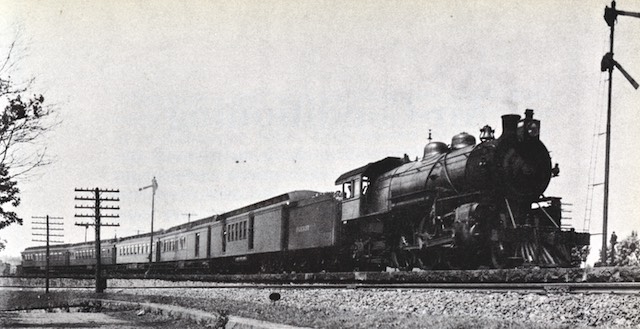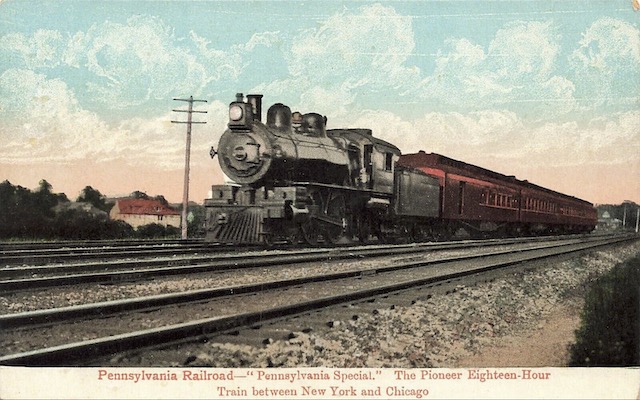My recent post about all-steel passenger cars raises the question: what was the first all-steel intercity train? The first all-steel train of any kind was undoubtedly an IRT subway train. The first all-steel intercity train was also clearly a Pennsylvania Railroad train, but which one? This question isn’t answered by the Railway Ages of the day, nor did the Pennsylvania mention its first all-steel train in the Official Guides.

The all-steel Pennsylvania Special in 1908. Click image for a larger view.
William Kratville, who wrote numerous books about (mostly Union Pacific) trains appears to definitively answer this question in his book, Steam, Steel and Limiteds: On page 11 of the 1962 edition of that book, he writes, “The Pennsylvania was first upon the scene with the all steel Pennsylvania Limited.”
However, page 15 of the same book has a photo of “The world’s first all-steel train, the Pennsylvania Special . . . in 1908.” Apparently, copy editors of railroad books weren’t as meticulous in those days. Since the Limited and the Special were two different trains, which one is correct?
The answer is undoubtedly the Special, which was the Pennsy’s premiere train after it was introduced on an 18-hour New York-Chicago schedule on June 11, 1905. The Pennsylvania Limited had been introduced in 1887 and was still on a 23-hour timetable in 1905 through 1908.
Both were extra-fare, all-Pullman trains, but the Limited took more time to pick up or drop off sleeping cars in Harrisburg, Pittsburg, Cleveland, Toledo and dining cars in Altoona and Crestline. The Special picked up or dropped off a Washington car in Harrisburg and a diner in Altoona and Crestline but otherwise was a solid train from New York to Chicago. When inaugurated in 1902, the Special also featured a bathtub and barber shop.
When PRR introduced the first limited train in 1881, it took about a year for the New York Central to offer its first limited. When the New York Central introduced the 20-hour Exposition Flyer in 1893, Pennsylvania didn’t try to match that time at all. (Beebe says the railroad started the Pennsylvania Special on a 20-hour schedule in 1893, but it isn’t in the July 1893 Official Guide.) One explanation is that the demand for New York-Chicago travel was low enough that the railroads didn’t consider it an important market.
That changed after the Columbian Exposition, which may have opened the eyes of both railroads regarding the potential of this market. For the next 70 years, the two railroads operated in keen competition with one another. At times, it seemed that they must have regularly consulted with one another about schedules and fares. Today this would be considered illegal collusion, but in the early 1900s it was probably considered a way to avoid ruinous competition.
The two railroads introduced the 20-hour 20th Century Limited and Pennsylvania Special on the same day in June, 1902. However, claiming that congestion prevented it from maintaining that schedule, the Pennsylvania dropped the Special from its timetable in late 1902.

The Pennsylvania Special became the “pioneer 18-hour” train by beating the New York Central by five days. Click image to download a 1.2-MB PDF of this postcard.
So it would have been a surprise when the June 8, 1905 issue of Railway Age reported that “the Vanderbilt and Pennsylvania Lines have entered upon a speed war between Chicago and New York.” First, the New York Central announced that it would reduce the time of the 20th Century Limited to 19 hours commencing on June 18.
The Pennsylvania didn’t take this lying down, and responded that it would restore the Pennsylvania Special to its timetables on June 11. Moreover, the train would take, not 19, but just 18 hours to carry passengers between Manhattan and Chicago (including a ferry ride across the Hudson). Apparently, it had solved whatever congestion problems existed in 1902.
Central traffic officials hastily convened and decided they could meet the 18-hour schedule starting June 16. The New York road also reduced the time of its Lake Shore Limited from 24 to 23 hours and the Manhattan Limited from 25 to 24 hours. This led the Pennsylvania to move up the schedule of its Pennsylvania Limited, which was already a 23-hour train, by half an hour so it would leave New York at exactly the same time as and compete directly with the Lake Shore Limited.
In the end, the Pennsylvania was able to advertise that it was the first to have an 18-hour schedule, but only by five days. In any case, that meant that, by 1908 when Pullman started producing large numbers of all-steel cars for Pennsylvania trains, the first train to be equipped with those cars would have been the Special, both because it was the premiere train and because it was shorter (only four or five cars depending on whether it had the diner) and so didn’t require as many new steel cars as the Limited. The New York Central — which apparently wasn’t as worried about fires in its tunnel approaching Grand Central Terminal — didn’t get serious about all-steel trains until 1910, when it “steeled” the 20th Century Limited.
